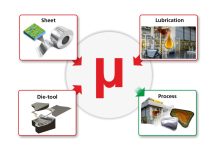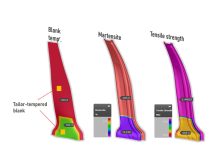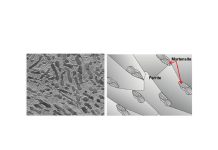Hope for the Best – But Prepare for the Worst
Within the sheet metal stamping industry, the goal of a process engineer is to define the process and geometric parameters based on which tools are built to produce a certain number of car body parts (i.e. 200,000 parts for a certain car volume). All of this must be within the required dimensional tolerances and meet the desired aesthetic quality. To achieve this goal in the virtual world – where changes are easy, fast and inexpensive – stamping process simulation software is used to define and validate all relevant process parameters. The tool manufacturing team and production line will then have to carry out the rest of the process in the “real” world.
Shifting from the virtual to the real world, simulating conditions that can be matched in reality is crucial for the efficiency of the entire process. However, can all parameters always be duplicated in reality – if so, within what tolerance? And finally, what does this mean for cost-time efficiency of the entire process?
In order to get to the bottom of these issues, we’re going to address one set of essential input parameters that significantly affect the reliability of the simulation results: material characteristics.
How close are the simulated material properties to the real material used in tool tryout and production? At the other end of the spectrum, what are the chances that the real material properties used in tryout will match the properties used in simulation? How would I even know whether I have a match? After all, the tests required to reach a meaningful mathematical description of the plastic deformation behavior of any sheet metal are totally different from the multiple stretching directions occurring in reality.
The figure below shows just some of the parameters needed to describe the behavior of the material and evaluation criteria (hardening curve, yield surface, forming limit diagram with FLC, etc.).

During the feasibility analysis of the part early on in the process, the grade of the material is defined by the carmaker. Further, the properties available to the process engineers are limited to what is generically specified, either by the OEM or by international standards (EN, DIN, VDA, etc.).
For instance, let’s assume the designed steel grade for the part is CR210xxx (Cold Rolled Steel, min. yield stress = 210 Mpa). Of course, we need to define far more parameters for the material behavior during stamping operations than simply yield (Rp0.2) and ultimate strength (Rm). But, for the sake of the example, we will focus on just these two parameters – and we’ll quickly realize how complicated the scenario becomes, even while neglecting all of the other necessary parameters!
In addition to this basic information, material makers provide a range of values for these characteristics in order to allow for typical scatter of real-life production conditions. Let’s assume we are dealing with the data shown in the table below.
![]()
Which values should we input for a feasibility study? One might suggest: let’s identify the worst-case scenario and go with that! Then the question becomes, what is the worst-case scenario?
Keep this concept in mind, as we’ll return to it later on.
The material supplier may be as yet undetermined during the advanced feasibility and full stamping process validation phases, particularly when the part producer is still shopping around for the best offers. Uncertainty abounds even while the engineering study is progressing and tools are being designed. The process has been digitally designed and validated, despite this looming uncertainty. Thus, the sooner the supplier is found, the better! However, supplier identification is a parallel process that often has nothing to do with the engineering study; it’s in the hands of the purchasing department.
Fortunately, the tools have not yet been manufactured by the time supplier negotiations are complete. The process engineer may still find a set of parameters to generate green results and deliver them downstream. If the tools are about to be milled, though, the game would be over for engineering since the data would simply arrive too late to be considered.
Now, let’s assume the information comes in before the tool geometries have been released. The process engineer is now considering not only material characteristics, but also statistical distributions of the material parameters (i.e. histograms) – provided by the material supplier. This data may appear as in the figure below.

Figure 1 – Typical statistical distributions (histograms) of material properties
In this case, if the process engineer sticks to the mean rule for the simulation set-up (this information is not yet available and a guess has to be made), using the mean value of the two ranges (yield Rp0.2=240MPa and ultimate Rm=375MPa) – the chances that the yield strength used in simulation will match that of the actual material received by the part producer at the plant is roughly 3.5% (7% x 50%)!
On the other hand, if the simulated values used were the minimum of the respective range (Rp0.2=210MPa and Rm=340MPa), the probability that the real material in production matches the simulated data is zero!
Fortunately, this doesn’t necessarily mean that the final part is 100% scrap – but it does mean that what will happen in reality has not been simulated at all.
Returning to our earlier consideration: what would be the worst-case scenario parameters? Truthfully, they all could have been good or bad. Before knowing the statistical distribution from the identified material supplier, the engineer can only make guesses.
Prior to production, tools are tested and fine-tuned during the tool tryout process. This is an iterative process, during which real panels are stamped and tools are modified until the desired quality of the final part is reached. Each single tool is released to production through tool buy-off only when the parts produced are compliant with the dimensional tolerances and the targeted quality.
What about the importance of the material type used during tool tryout?
Ideally, the material should be the same in both tryout and production, provided by the same supplier and with the same statistical distribution. Nevertheless, even if this was the case, can you imagine what would happen if the material used in tool tryout had Rm = 400MPa (refer to fig.1)?
In this case, the tools would be adjusted to produce panels based on material property with roughly a 2% chance of being used in production! Actually, if we assume that the material used in tryout has Rp0.2 = 225MPa, the chances of using the same material in production is now 2% x 50% = 1%.
Again, this does not mean that we will need to scrap 99%. Rather, in 99% of the cases, we cannot know how the material will behave during production, as the properties change from coil to coil and even within the same coil.
By the way: just imagine the math involved to determine all of the remaining combinations!
If this were true, the question would become: “How could we ever make cars?” Fortunately, there is no black and white engineering process – but we should think about the costs involved.
As long as the engineered process is sensitive to material property variations, the risk of issues arising in tool tryout and production is particularly high for aluminum or high strength steel grades.
An example of this scenario is shown in the image below. The common engineering approach showed good results, but fortunately (or unfortunately, depending on perspective), an unacceptable amount of springback was detected during tool tryout by measuring the scanned part. A stability check of the engineering results was then conducted to identify the root cause and countermeasures, which highlighted possible issues due to material variation. They showed an unacceptable process stability (w.r.t. springback) in the area where the issue manifested.

The effect experienced by the uncertainty of material property variations (which cannot be avoided due to the way material is produced) can only be reduced to a minimum by evaluating the process stability. The typical results produced by a single set of simulation parameters (e.g., formability, splits, wrinkles, springback, etc.) – despite incorporating lots of engineering data – ignore the noise (variation) effect generated by the material properties.
Adopting additional analysis criteria becomes even more important if we consider that other parameters (e.g., thickness and friction) are not constant in reality either, but have to be taken into account in the stability check as well.
Engineering a process that is insensitive to material parameter variation means eliminating a dangerous variable on your production line. Of course, there are variables we cannot control and materials must sometimes be taken “as is”, so there will always be some aspect of dealing with matters once it arrives. There will consequently be adjustments made during production, a number of shut downs, scrap, etc. – in short, it is an issue of cost and time.
The goal of process engineering is to develop a stamping process capable of producing not a single part but 200,000 parts (for example) at the most manageable cost. To achieve this goal, the stamping process needs to be designed for production. This is only possible when we simulate the real production conditions, considering all known parameter variations that cannot be eliminated since they are part of the process itself.
You may also want to read this post about the importance of material cards.













